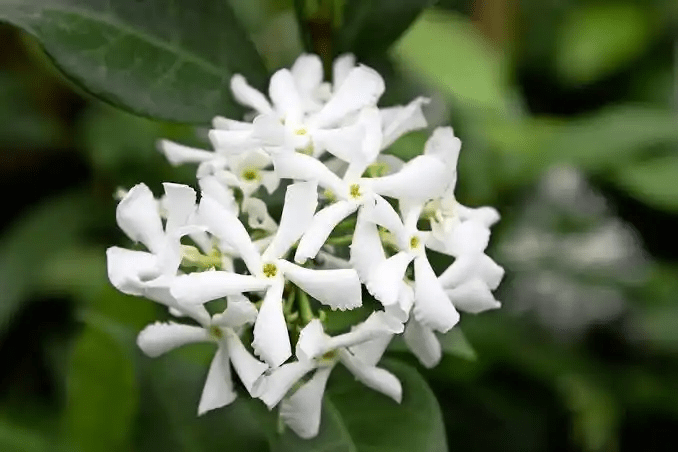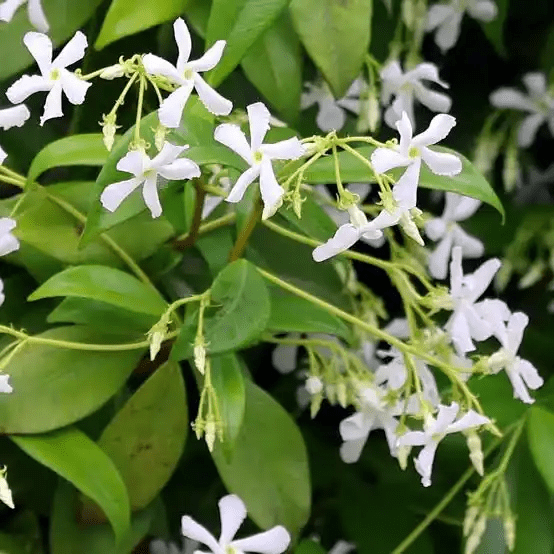Trachelospermum jasminoides, commonly known as Confederate jasmine or Star Jasmine, is a versatile and fragrant evergreen vine belonging to the Apocynaceae family. Native to East and Southeast Asia, this plant has gained popularity for its lush, glossy foliage and the sweet, intoxicating fragrance of its small, star-shaped white flowers.
It is widely cultivated as a decorative climbing vine and ground cover in various temperate and subtropical regions around the world.
The leaves of Trachelospermum jasminoides are leathery, dark green, and arranged in opposite pairs along the stems. They are ovate to lanceolate in shape, reaching about 2 to 4 centimeters in length.
The dense foliage creates a thick cover, making it an excellent choice for concealing fences, walls, and arbors. The glossy appearance of the leaves adds an elegant touch to the overall aesthetic of the plant.
One of the most distinctive features of Confederate jasmine is its fragrant flowers. Clusters of small, white blooms appear in late spring to early summer, releasing a sweet and captivating scent that fills the air.
The fragrance is reminiscent of true jasmine, earning the plant its common name, though it is not botanically related to the true jasmine genus (Jasminum).
Trachelospermum jasminoides is known for its adaptability to various growing conditions. It thrives in well-drained soil and prefers a location with full to partial sunlight.
The plant is relatively low-maintenance, and once established, it exhibits good drought tolerance. Regular watering during dry periods and occasional pruning to shape and control its growth are generally sufficient for its care.
This evergreen vine is a popular choice for landscaping and garden design, adding vertical interest to outdoor spaces. It can be trained to climb trellises, arbors, and pergolas, providing not only visual appeal but also a fragrant ambiance.
Additionally, it serves as an effective ground cover, creating a lush carpet of greenery in garden beds.
Propagation of Trachelospermum jasminoides is commonly done through stem cuttings. The plant roots easily, making it a practical option for gardeners looking to expand their Confederate jasmine collection or share the beauty of this fragrant vine with others.
Trachelospermum jasminoides, or Confederate jasmine, is a delightful and versatile evergreen vine celebrated for its glossy foliage and sweetly scented white flowers.
Whether used to adorn vertical structures or as a ground cover, this plant brings a touch of elegance and olfactory pleasure to gardens, making it a cherished addition to landscapes around the world.
The Botanical Description of Trachelospermum jasminoides
1. Leaves: Trachelospermum jasminoides, commonly known as Confederate jasmine, boasts evergreen, glossy leaves. These leaves are leathery in texture and arranged oppositely along the stems. They are ovate or lanceolate, showcasing a rich green color that enhances the plant’s aesthetic appeal.
2. Flowers: The botanical charm of T. jasminoides is accentuated by its fragrant, star-shaped flowers. These blooms appear in clusters and can be white or creamy, emitting a sweet and pleasant fragrance. The flowers contribute to the ornamental value of the plant.
3. Growth Habit: This species exhibits a twining or trailing growth habit, making it well-suited for climbing structures or cascading over walls. The vine-like nature of T. jasminoides allows it to create a lush and visually appealing green cover.
4. Fruits: While not a prominent feature, T. jasminoides does produce small, berry-like fruits. These fruits are generally inconspicuous and do not play a significant role in the overall aesthetic or botanical appeal of the plant.
The Geographic Distribution of Trachelospermum jasminoides
1. Native Regions: Trachelospermum jasminoides is native to East and Southeast Asia, including China, Japan, and Korea. It thrives in a subtropical to tropical climate, where it can enjoy warm temperatures and well-drained soils.
2. Global Cultivation: Due to its ornamental value, T. jasminoides has been cultivated and introduced to various regions worldwide. It can be found in gardens, landscapes, and horticultural settings in regions with suitable climates.
3. Climatic Preferences: Confederate jasmine prefers regions with mild winters and warm, humid summers. It can tolerate a range of soil types but thrives in well-drained, slightly acidic to neutral soils.
4. Ornamental Landscaping: The plant’s adaptability has made it a popular choice for ornamental landscaping in many parts of the world. It is often used to cover walls, fences, or trellises, adding a touch of elegance to outdoor spaces.
The Chemical Composition of Trachelospermum jasminoides
1. Essential Oils: Trachelospermum jasminoides contains essential oils that contribute to its distinctive fragrance. These oils, extracted from various parts of the plant, play a role in the aromatic appeal that makes the species prized in horticulture.
2. Phenolic Compounds: Phenolic compounds, known for their antioxidant properties, are present in T. jasminoides. These compounds contribute to the plant’s overall health and may have implications for human health when used in traditional medicine.
3. Alkaloids: While not as pronounced as in some other plant species, T. jasminoides may contain trace amounts of alkaloids. The presence of alkaloids contributes to the plant’s chemical complexity and may have ecological significance.
4. Aromatic Molecules: Beyond the essential oils, T. jasminoides likely contains various aromatic molecules that contribute to its distinctive scent. These molecules play a role in the plant’s interaction with its environment, including attracting pollinators.
Trachelospermum jasminoides stands out not only for its botanical beauty but also for its adaptability to different climates. Understanding its botanical description, geographic distribution, and chemical composition enhances the appreciation of this ornamental plant in both natural and cultivated settings.
Read Also: Which Herbs and Spices are good for you (cinnamon, paprika, etc)
The Medicinal Health Benefits Of Trachelospermum jasminoides (Confederate Jasmine)

1. Respiratory Health Support: Confederate jasmine is known for its potential to support respiratory health, aiding in conditions like coughs and congestion due to its aromatic compounds.
2. Stress Reduction and Relaxation: The fragrant blooms emit a calming scent, contributing to stress reduction and promoting relaxation for both mental and physical well-being.
3. Skin Health Enhancement: Compounds contribute to skin health, with traditional uses involving preparations to soothe skin irritations and promote a healthy complexion.
4. Antioxidant Properties: Believed to possess antioxidant properties due to phenolic compounds, playing a crucial role in neutralizing free radicals and reducing oxidative stress.
5. Analgesic Effects: Traditional uses include potential analgesic effects, offering anecdotal relief for mild pain.
6. Anti-Inflammatory Benefits: Scientific research suggests potential anti-inflammatory effects, making it valuable in managing conditions associated with inflammation.
7. Calming Effects on the Nervous System: The aromatic profile may have calming effects on the nervous system, reducing anxiety and promoting overall mental well-being.
8. Digestive Aid: Traditional uses involve Confederate jasmine as a digestive aid, helping soothe digestive discomfort and support overall gastrointestinal health.
9. Mild Sedative Properties: The calming nature extends to potential mild sedative properties, contributing to relaxation and benefiting individuals with mild sleep disturbances.
10. Immune System Support: Compounds may offer immune system support, contributing to overall immune health.
The Methods of Usage to Achieve the Provided Health Benefits Of Trachelospermum jasminoides (Confederate Jasmine)
1. Aromatherapy: Utilize Confederate jasmine for health benefits through aromatherapy. Essential oils can be diffused or added to massage oils for stress reduction and relaxation.
2. Topical Applications: Apply Confederate jasmine preparations topically for skin health. Creams, lotions, or infused oils may address skin irritations or enhance complexion with sensitivity testing.
3. Inhalation: Enjoy the fragrance of Confederate jasmine flowers for potential respiratory benefits. Placing blooms in sachets or well-ventilated spaces supports respiratory well-being.
4. Herbal Infusions: Prepare herbal infusions or teas with Confederate jasmine leaves for internal consumption, providing antioxidant benefits and supporting overall health.
5. Compresses and Poultices: In traditional medicine, use Confederate jasmine for localized pain relief through compresses or poultices, guided by proper instructions.
The Side Effects Of Using Trachelospermum jasminoides Medicinal Plant
1. Skin Sensitivity: Topical applications may cause skin sensitivity or allergic reactions. Conduct patch tests before use to avoid adverse effects.
2. Internal Use Caution: Caution is advised for internal consumption, and consultation with healthcare professionals is recommended to prevent adverse reactions.
3. Potential Respiratory Irritation: Excessive inhalation of fragrances, even natural ones like Confederate jasmine, may cause respiratory irritation. Ensure adequate ventilation in aromatherapy.
4. Interaction with Medications: Potential interactions with medications may occur. Consult healthcare professionals before incorporating Confederate jasmine into health regimens.
5. Allergic Reactions: While rare, allergic reactions can occur. Individuals with known allergies to plants in the Apocynaceae family should exercise caution and seek professional advice.
Trachelospermum jasminoides shows promise for various health benefits, but it is crucial to use it judiciously and be aware of potential side effects. Always consult with healthcare professionals before incorporating it into medicinal practices.
Read Also: Crop Yield Estimation and Agriculture Science with GIS
The Scientific Research and Studies of Trachelospermum jasminoides

1. Antimicrobial Properties: Scientific studies indicate that Trachelospermum jasminoides exhibits antimicrobial properties. Compounds within the plant have demonstrated inhibitory effects against various microorganisms, suggesting potential applications in traditional medicine.
2. Phytochemical Analysis: Extensive phytochemical analysis has been conducted to understand the chemical composition of Confederate jasmine. This research has identified essential oils, phenolic compounds, and other bioactive molecules, contributing to the plant’s medicinal attributes.
3. Anti-Inflammatory Effects: Scientific investigations have explored the anti-inflammatory effects of Trachelospermum jasminoides. Results suggest the plant may modulate inflammatory responses, making it a subject of interest for conditions involving inflammation.
4. Antioxidant Capacity: Research has focused on the antioxidant capacity of Confederate jasmine. The plant’s ability to scavenge free radicals may reduce oxidative stress, with potential implications for various health benefits.
5. Wound Healing Properties: Scientific studies have examined the wound healing properties of Trachelospermum jasminoides. Preparations from the plant have shown promise in promoting the healing of skin wounds, offering potential applications in dermatological care.
The Safety Precautions and Recommendations In Using Trachelospermum jasminoides Medicinal Plant
1. Patch Testing for Sensitivity: Before extensive use, conduct patch tests to assess individual sensitivity to Confederate jasmine. This precaution helps identify potential allergic reactions and ensures safer usage.
2. Controlled Dosage Guidance: Adhering to controlled dosage recommendations is crucial to mitigate the risk of adverse effects. Herbal practitioners or healthcare professionals can provide guidance on appropriate dosage for specific health conditions.
3. Professional Consultation: Seek professional consultation before incorporating Confederate jasmine into medicinal practices. Healthcare providers can offer personalized advice, considering individual health history and potential interactions with other medications.
4. Handling and Preparation Protocols: Proper handling of Confederate jasmine during preparation is vital to avoid direct contact with skin and potential irritation. Wearing protective clothing and gloves is recommended.
5. Monitoring for Adverse Effects: Regularly monitor for side effects during medicinal use. Any signs of adverse reactions, such as increased skin irritation or allergic symptoms, should prompt immediate discontinuation and consultation with a healthcare professional.
FAQs About Trachelospermum jasminoides Medicinal Plant
1. Q: Can Confederate jasmine be used internally for medicinal purposes?
Internal use of Confederate jasmine should be approached with caution due to potential toxicity. Consulting with a healthcare professional is crucial before considering internal applications.
2. Q: How long does it take to see the medicinal benefits of Confederate jasmine?
The time to observe benefits may vary. Topical applications may show quicker results, while systemic effects might take longer. Patience and consistent usage are key.
3. Q: Are there any contraindications for using Confederate jasmine medicinally?
Individuals with known allergies or sensitivities to Confederate jasmine should avoid medicinal use. Pregnant or breastfeeding individuals should also consult healthcare professionals before use.
4. Q: Can Confederate jasmine be cultivated for medicinal purposes at home?
Cultivating Confederate jasmine at home is not recommended due to the risk of accidental contact and potential health hazards. It is safer to source controlled preparations from reputable sources.
5. Q: What should I do if I experience adverse effects from using Confederate jasmine medicinally?
Discontinue use immediately and seek medical attention. Inform healthcare providers about the medicinal application to facilitate appropriate treatment and guidance.
Read Also: Anthropogenic Sources of Pollution
